Yosemite Association Seminar #42 - Day Hike on August 14, 2003
Lyell Canyon
-
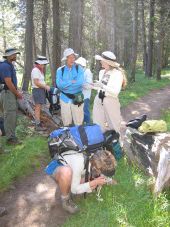 The group looks at elephant ears. Lisa, our leader, is the one in the floppy hat and gloves.
The group looks at elephant ears. Lisa, our leader, is the one in the floppy hat and gloves.
-
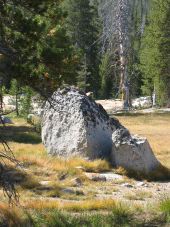 If you look closely, you can see a marmot on the big rock. Marmot was my nature name (we each had Nature Names so we could remember each other's names better.)
If you look closely, you can see a marmot on the big rock. Marmot was my nature name (we each had Nature Names so we could remember each other's names better.)
-
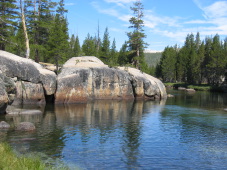 Lyell Fork of the Tuolumne River.
Lyell Fork of the Tuolumne River.
-
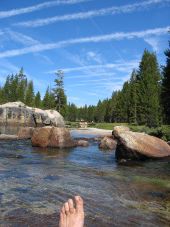 with toes in icy water.
with toes in icy water.
-
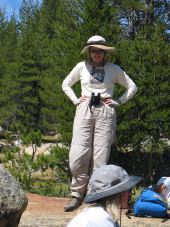 Lisa Strong-Aufhauser, of Strong Productions, is our leader and wildlife expert. She's a photographer and videographer.
Lisa Strong-Aufhauser, of Strong Productions, is our leader and wildlife expert. She's a photographer and videographer.
-
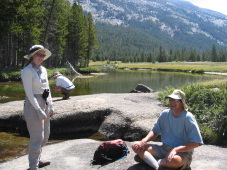 Lisa and Jeffrey Pine.
Lisa and Jeffrey Pine.
-
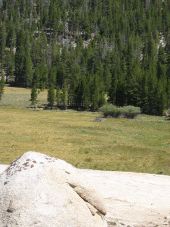 The low-growing "bushes" in mid-distance are a particular species of willow. They grow in interesting playing-top shapes.
The low-growing "bushes" in mid-distance are a particular species of willow. They grow in interesting playing-top shapes.
-
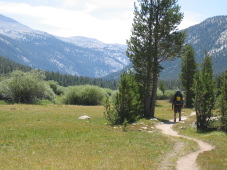 A sturdy backpacker walking towards Lyell Canyon.
A sturdy backpacker walking towards Lyell Canyon.
-
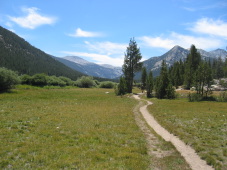 Our trail ahead is smooth and flat.
Our trail ahead is smooth and flat.
-
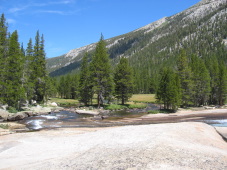 Tuolumne River running over large, smooth expanses of granite.
Tuolumne River running over large, smooth expanses of granite.
-
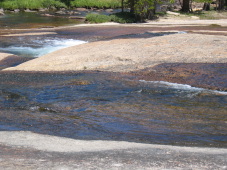 Water and stone.
Water and stone.
-
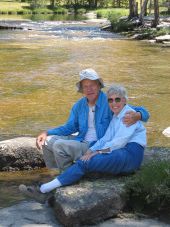 Brother and sister from Lake Arrowhead, in Southern California.
Brother and sister from Lake Arrowhead, in Southern California.
-
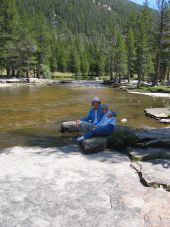 And some more perspective on teh scenery.
And some more perspective on teh scenery.
-
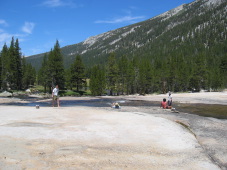 Huge granite rocks invite hikers to lie down and take off boots.
Huge granite rocks invite hikers to lie down and take off boots.
-
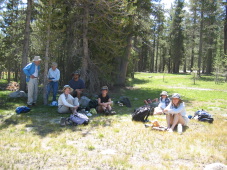 The gang! Or about half of us, anyway.
The gang! Or about half of us, anyway.
-
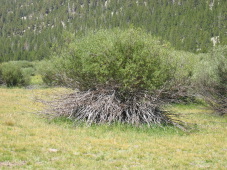 This is a perfect picture (if I do say so myself) of how this particular willow tree grows. The lower half is a wonderful habitat for birds.
This is a perfect picture (if I do say so myself) of how this particular willow tree grows. The lower half is a wonderful habitat for birds.
-
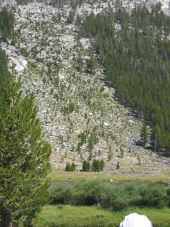 Evidence of an avalanche on a far slope.
Evidence of an avalanche on a far slope.
-
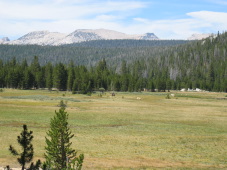 Far-away horse?
Far-away horse?
-
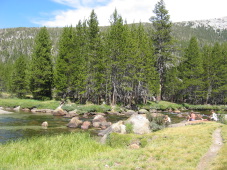 Tuolumne River
Tuolumne River
-
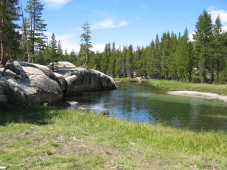 Same rocks as in picture #3, just later in the day. On the way back home to our campsites in Tuolumne Meadows Campground.
Same rocks as in picture #3, just later in the day. On the way back home to our campsites in Tuolumne Meadows Campground.
-
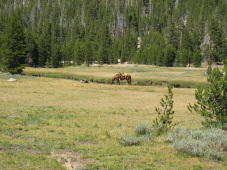 Horse nibbling grass in meadow.
Horse nibbling grass in meadow.
-
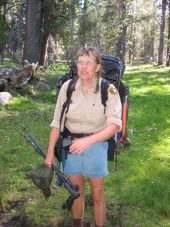 On the way back, we crossed paths with an incredible and energetic National Park Service volunteer who regaled us with tales of bears. She was on her way incountry to see if folks were using bear canisters and to urge them to do so.
On the way back, we crossed paths with an incredible and energetic National Park Service volunteer who regaled us with tales of bears. She was on her way incountry to see if folks were using bear canisters and to urge them to do so.
-
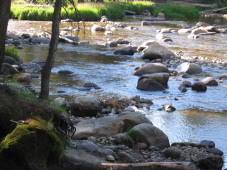 Tuolumne River rocks, late in the afternoon.
Tuolumne River rocks, late in the afternoon.
-
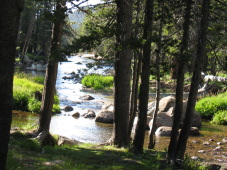 Tuolumne River shade and sun, late in the afternoon.
Tuolumne River shade and sun, late in the afternoon.
-
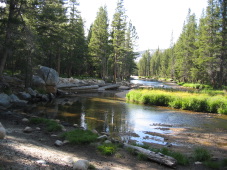 One mo' agin'.
One mo' agin'.
-
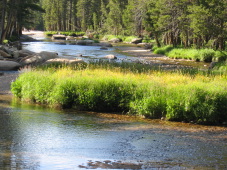 Reeds in the late day sun.
Reeds in the late day sun.
-
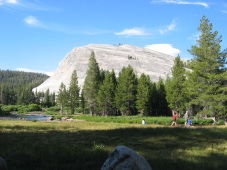 Lembert Dome, late in the day.
Lembert Dome, late in the day.
-
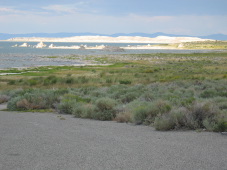 I drove from the Tuolumne Meadows area out to spectacular Mono Lake and the town of Lee Vining. I was in search of a yuppie dining experience at the Mono Inn. This is a shot of Mono Lake with tufa. According to the Mono Lake Tufa State Reserve website, "The tufa towers are the most obvious geological feature at Mono Lake. These unusual spires and knobs are formed when calcium-bearing freshwater springs well up through alkaline lake water, which is rich in carbonates. The calcium and carbonate combine, precipitating out as limestone. Over many years, a tower forms around the mouth of the spring. This tufa-forming reaction happens only in the lake itself. As the lake level drops, exposing the towers, they cease to grow."
I drove from the Tuolumne Meadows area out to spectacular Mono Lake and the town of Lee Vining. I was in search of a yuppie dining experience at the Mono Inn. This is a shot of Mono Lake with tufa. According to the Mono Lake Tufa State Reserve website, "The tufa towers are the most obvious geological feature at Mono Lake. These unusual spires and knobs are formed when calcium-bearing freshwater springs well up through alkaline lake water, which is rich in carbonates. The calcium and carbonate combine, precipitating out as limestone. Over many years, a tower forms around the mouth of the spring. This tufa-forming reaction happens only in the lake itself. As the lake level drops, exposing the towers, they cease to grow."
-
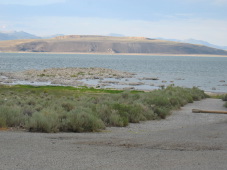 Another shot of beautiful Mono Lake, at sunset.
Another shot of beautiful Mono Lake, at sunset.
-
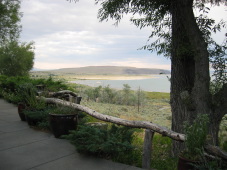 The view from the back porch of Mono Inn, which is a few miles north of Lee Vining, on the right hand side. Glorious place, looks like it would be wonderful if expensive to stay there.
The view from the back porch of Mono Inn, which is a few miles north of Lee Vining, on the right hand side. Glorious place, looks like it would be wonderful if expensive to stay there.
-
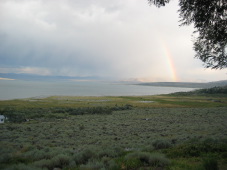 A rainbow appears! Actually, so did a thunderstorm, lighting, and a few drops of rain. Most of the rain was off to the south, so I continued my dinner out on the porch.
A rainbow appears! Actually, so did a thunderstorm, lighting, and a few drops of rain. Most of the rain was off to the south, so I continued my dinner out on the porch.
-
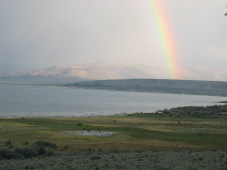 A closer view of the rainbow.
A closer view of the rainbow.
-
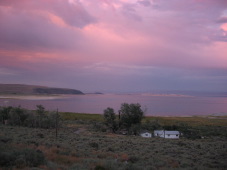 Sunset ...
Sunset ...
-
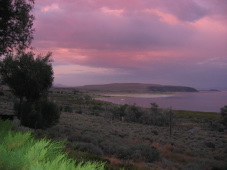 ... sunset ...
... sunset ...
-
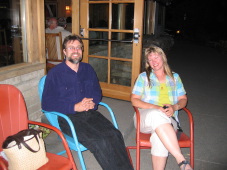 New friends at the Mono Inn - she had hiked with Lisa a few years earlier! Her nature name was Lodgepole Lori.
New friends at the Mono Inn - she had hiked with Lisa a few years earlier! Her nature name was Lodgepole Lori.
Marianne Mueller
Last modified: October 30, 2003
 The group looks at elephant ears. Lisa, our leader, is the one in the floppy hat and gloves.
The group looks at elephant ears. Lisa, our leader, is the one in the floppy hat and gloves.
 If you look closely, you can see a marmot on the big rock. Marmot was my nature name (we each had Nature Names so we could remember each other's names better.)
If you look closely, you can see a marmot on the big rock. Marmot was my nature name (we each had Nature Names so we could remember each other's names better.)
 Lyell Fork of the Tuolumne River.
Lyell Fork of the Tuolumne River.
 with toes in icy water.
with toes in icy water.
 Lisa Strong-Aufhauser, of Strong Productions, is our leader and wildlife expert. She's a photographer and videographer.
Lisa Strong-Aufhauser, of Strong Productions, is our leader and wildlife expert. She's a photographer and videographer.
 Lisa and Jeffrey Pine.
Lisa and Jeffrey Pine.
 The low-growing "bushes" in mid-distance are a particular species of willow. They grow in interesting playing-top shapes.
The low-growing "bushes" in mid-distance are a particular species of willow. They grow in interesting playing-top shapes.
 A sturdy backpacker walking towards Lyell Canyon.
A sturdy backpacker walking towards Lyell Canyon.
 Our trail ahead is smooth and flat.
Our trail ahead is smooth and flat.
 Tuolumne River running over large, smooth expanses of granite.
Tuolumne River running over large, smooth expanses of granite.
 Water and stone.
Water and stone.
 Brother and sister from Lake Arrowhead, in Southern California.
Brother and sister from Lake Arrowhead, in Southern California.
 And some more perspective on teh scenery.
And some more perspective on teh scenery.
 Huge granite rocks invite hikers to lie down and take off boots.
Huge granite rocks invite hikers to lie down and take off boots.
 The gang! Or about half of us, anyway.
The gang! Or about half of us, anyway.
 This is a perfect picture (if I do say so myself) of how this particular willow tree grows. The lower half is a wonderful habitat for birds.
This is a perfect picture (if I do say so myself) of how this particular willow tree grows. The lower half is a wonderful habitat for birds.
 Evidence of an avalanche on a far slope.
Evidence of an avalanche on a far slope.
 Far-away horse?
Far-away horse?
 Tuolumne River
Tuolumne River
 Same rocks as in picture #3, just later in the day. On the way back home to our campsites in Tuolumne Meadows Campground.
Same rocks as in picture #3, just later in the day. On the way back home to our campsites in Tuolumne Meadows Campground.
 Horse nibbling grass in meadow.
Horse nibbling grass in meadow.
 On the way back, we crossed paths with an incredible and energetic National Park Service volunteer who regaled us with tales of bears. She was on her way incountry to see if folks were using bear canisters and to urge them to do so.
On the way back, we crossed paths with an incredible and energetic National Park Service volunteer who regaled us with tales of bears. She was on her way incountry to see if folks were using bear canisters and to urge them to do so.
 Tuolumne River rocks, late in the afternoon.
Tuolumne River rocks, late in the afternoon.
 Tuolumne River shade and sun, late in the afternoon.
Tuolumne River shade and sun, late in the afternoon.
 One mo' agin'.
One mo' agin'.
 Reeds in the late day sun.
Reeds in the late day sun.
 Lembert Dome, late in the day.
Lembert Dome, late in the day.
 I drove from the Tuolumne Meadows area out to spectacular Mono Lake and the town of Lee Vining. I was in search of a yuppie dining experience at the Mono Inn. This is a shot of Mono Lake with tufa. According to the Mono Lake Tufa State Reserve website, "The tufa towers are the most obvious geological feature at Mono Lake. These unusual spires and knobs are formed when calcium-bearing freshwater springs well up through alkaline lake water, which is rich in carbonates. The calcium and carbonate combine, precipitating out as limestone. Over many years, a tower forms around the mouth of the spring. This tufa-forming reaction happens only in the lake itself. As the lake level drops, exposing the towers, they cease to grow."
I drove from the Tuolumne Meadows area out to spectacular Mono Lake and the town of Lee Vining. I was in search of a yuppie dining experience at the Mono Inn. This is a shot of Mono Lake with tufa. According to the Mono Lake Tufa State Reserve website, "The tufa towers are the most obvious geological feature at Mono Lake. These unusual spires and knobs are formed when calcium-bearing freshwater springs well up through alkaline lake water, which is rich in carbonates. The calcium and carbonate combine, precipitating out as limestone. Over many years, a tower forms around the mouth of the spring. This tufa-forming reaction happens only in the lake itself. As the lake level drops, exposing the towers, they cease to grow."
 Another shot of beautiful Mono Lake, at sunset.
Another shot of beautiful Mono Lake, at sunset.
 The view from the back porch of Mono Inn, which is a few miles north of Lee Vining, on the right hand side. Glorious place, looks like it would be wonderful if expensive to stay there.
The view from the back porch of Mono Inn, which is a few miles north of Lee Vining, on the right hand side. Glorious place, looks like it would be wonderful if expensive to stay there.
 A rainbow appears! Actually, so did a thunderstorm, lighting, and a few drops of rain. Most of the rain was off to the south, so I continued my dinner out on the porch.
A rainbow appears! Actually, so did a thunderstorm, lighting, and a few drops of rain. Most of the rain was off to the south, so I continued my dinner out on the porch.
 A closer view of the rainbow.
A closer view of the rainbow.
 Sunset ...
Sunset ...
 ... sunset ...
... sunset ...
 New friends at the Mono Inn - she had hiked with Lisa a few years earlier! Her nature name was Lodgepole Lori.
New friends at the Mono Inn - she had hiked with Lisa a few years earlier! Her nature name was Lodgepole Lori.